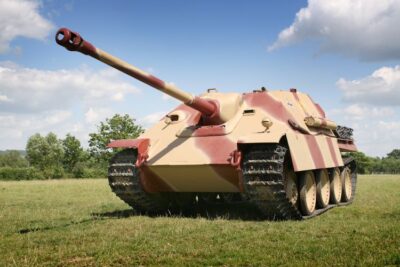Jagdpanther (8.8 cm Pak) - Sd.Kfz.173 Ausf. G2

About Jagdpanther '411'
February 1945. Even in the final stages of defeat somehow the assembly plants continued to function. At MNH (Maschinenfabrik Niedersachsen-Hannover) one of the last batches of Jagdpanther were loaded onto a train and dispatched to the front. Among them was Fahrgestell Nr (chassis number) 303086, soon to be lost from sight in the maelstrom of the final days of the Third Reich. Fifty years later in 2000, the Foundation purchased two wrecked Jagdpanther from a collector in Germany.
Unfortunately, after years of being used as range targets, both were riddled with holes and missing substantial parts of their armour. The first Jagdpanther (No.1) had been recovered from the Pirbright ranges, England in the 1970s in exchange for an artillery piece. The second Jagdpanther (No.2) had been salvaged from a British range in northern Germany and was in by far the worse condition.
The first order of business was to establish both Jagdpanther production lineage and then, if possible, their unit histories. An initial survey of Jagdpanther No.1 revealed that the chassis number was unreadable. Jagdpanther No.2 had a chassis number 303 110. 303 being the batch allocated to MNH and 110 - the 110th vehicle off the assembly line.
It was decided that Jagdpanther No.1 (Jagdpanther 411) was the candidate for restoration. The overall task not only required obtaining Jagdpanther parts, repairing existing parts, or in some cases manufacturing new parts; it also required extensive research not only involving our research team but also help from various external sources. The Jagdpanther underwent 10 years of restoration. This was a very expensive and complex undertaking which required a considerable amount of outsourced engineering, years of tracking down the required original radio and intercom equipment, main gun etc and a tremendous amount of intricate and backbreaking work.
- This article has 823 words
- Reading time: 4 minutes
- There is 1 photo
Become a Member - Access the Full Article
Members gain access to the full content of our articles, including photo galleries.


